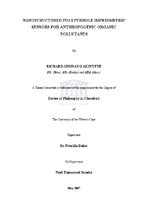| dc.description.abstract | Polypyrrole composites of polyaromatic hydrocarbon sulphonic acids (β–naphthalene sulphonic acid (NSA) and 1, 2-napthaquinone-4-sulphonic acid (NQS)), as well as those of transition metal oxides (tungsten (VI) oxide (WO3) and zirconium (IV) oxide (ZrO2)), were prepared and characterised for use as electrocatalytic sensors. The polymerization of pyrrole in β–naphthalene sulphonic acid (NSA) gave rise to nanotubules, nanomicelles or nanosheets polypyrrole (PPy) morphologies depending on the amount of NSA in the polymer and the polymerisation temperature. Scanning electron microscopy (SEM) measurements showed that the diameters of the nanostructured polypyrrole-β-naphthalene sulphonic acid (PPyNSA) composites were
150-3000 nm for the tubules, 100-150 nm for the micelles and 20 nm for the sheets. A red shift in the UV-Vis absorption spectra of PPy was observed for PPyNSA which is indicative of the involvement of bulky β-naphthalene sulphonate ion in the
polymerization process. The UV-Vis also showed the existence of polaron and bipolaron in the polymer which may be responsible for the improved solubility of PPyNSA compared to PPy. All the characteristic IR bands of polypyrrole were
observed in the FTIR spectra of PPyNSA, with slight variation in the absolute values. However, the absence of N–H stretching at 3400 cm-1 and 1450 cm-1 usually associated
with neutral polypyrrole confirms that the polymer is not in the aromatic state but in the excited polaron and bipolaron defect state. Electrochemical analysis of PPyNSA reveals
two redox couples: a/a′ - partly oxidized polypyrrole-naphthalene sulphonate radical cation/neutral polypyrrole naphthalene sulphonate; b/b′ - fully oxidized naphthalene
sulphonate radical cation/partly reduced polypyrrole-naphthalene sulphonate radical anion. The corresponding formal potentials measured at 5 mV/s, Eº'(5 mV/s), are 181 mV and 291 mV, respectively. Analysis of the amperometric response of GCE/PPyNSA film to phenol gave sensitivities of 3.1 mA/mole dm-3 with a linear correlation coefficient of 0.982 for phenol concentrations of 19.8 μM to 139.5 μM. The apparent Michaelis-Menten constant (Km′) was estimated as 160 μM. Novel polypyrrole thin film microelectrodes prepared from an aqueous solution of the sodium salt of 1, 2- apthaquinone-4-sulphonic acid and pyrrole in hydrochloric acid as the supporting electrolyte was characterized electrochemically for the first time and found to exhibit good electronic and spectroscopic properties. The modified PPyNQS
consisted of nano micelles with diameters of 50–100 nm. It also exhibited more pronounced voltammetric redox responses, improved solubility and stronger UV-Vis
absorptions at wavelengths for polarons (380 nm), bipolarons (750 nm) and overlapped bi-polarons (820 nm) compared to conventional PPy. Voltammetric investigations showed that the polymer exhibited quasi-reversible kinetics in a potential window of - 400 mV to +700 mV, with a formal potential of 322 mV vs. Ag/AgCl. The diffusion coefficient was calculated to be 1.02 x 10-6 cm2/s for a thin film with a surface
concentration of 1.83 x 10-7 mol/cm2 and a standard rate constant of 2.20 x 10-3 cm/s at 5 mV/s. Substractively normalised in situ Fourier transform infrared spectroscopy
(SNIFTIR) confirmed the incorporation of the surfactant into the polypyrrole film, and for the first time structural changes within the polymer were observed and used to explain the electrochemistry of the polymer. Electrochemical impedance spectroscopy (EIS) results validated the quasi-reversible kinetics observed in the voltammetric experiment. The changes in electrical properties of the polymer during electrochemical p-doping and n-doping were quantified by equivalent electrical circuit fitting. Impedimetric nanosensor systems for the determination of two anthropogenic organic
pollutants, namely benzidine and naphthalene, were constructed with smart Pt/PPyNQS nanomaterials. Analysis of sensor systems containing tungsten oxide or zirconium oxide-modified polypyrrole showed that nanohybrids of the polypyrrole were generated by the in-situ polymerisation of pyrrole in acidic solutions. Results from morphological and spectroscopic investigation confirmed the pattern of metal distribution within the nanohybrid polymers matrix. However, this class of polymers were devoid of charge carriers characteristics required for electrocatalytic sensor applications. The thesis provided justification for the preparation of nanostructured conducting polypyrrole for
use as anodes for the determination of phenol, benzidine and naphthalene. | en_US |

